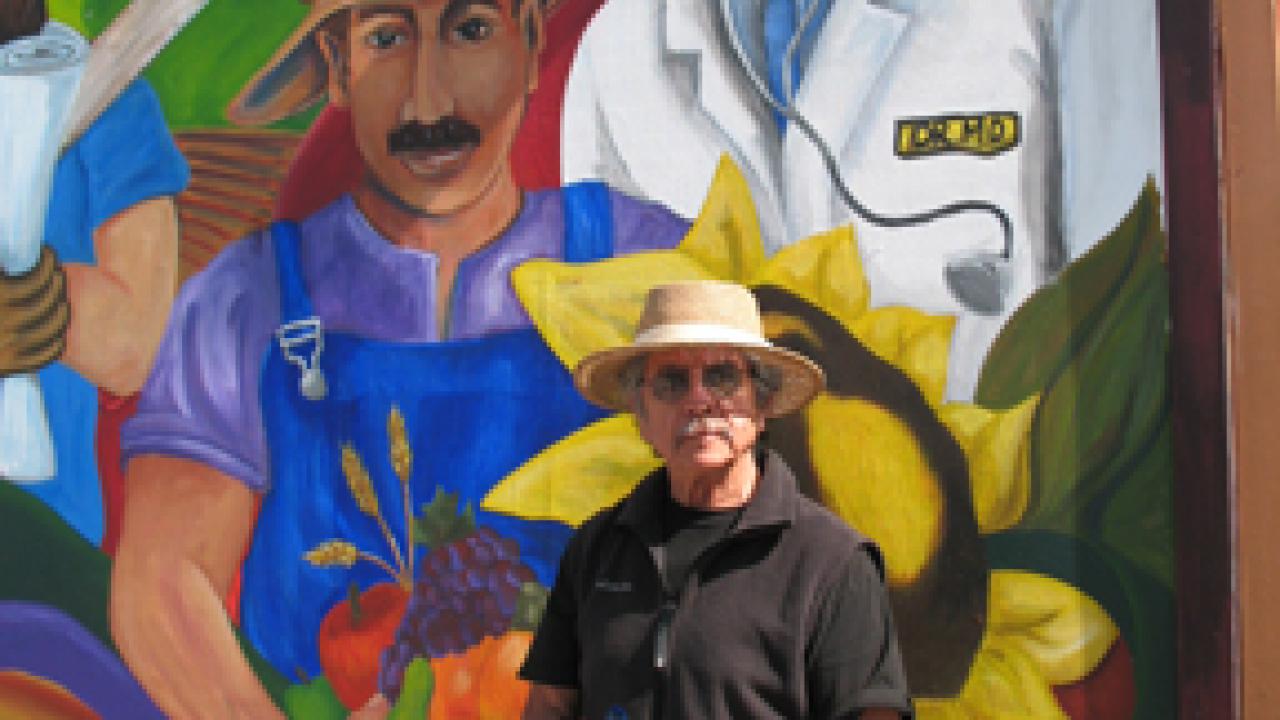Malaquias Montoya has used his "art of protest" to champion farmworkers, oppose the Vietnam War and fight the death penalty. Now he is using it to inspire California kids in rural towns like Elmira, Knights Landing and Dixon.
Montoya's latest project -- a 12-by-40-foot mural at Beamer Park Elementary School in Woodland -- was completed May 31.
"It's nice to give a gift, brighten up a school, tell a story," said Montoya, a professor of Chicana/Chicano studies and art and art history at UC Davis. "It's a way for the university to give to schools that are always underfunded, particularly in the arts."
Among the most prominent living Chicano artists, Montoya's work is in the collections of the Smithsonian Institution in Washington, D.C., the Mexican Fine Arts Center Museum in Chicago, the Los Angeles County Museum of Art, and more than a dozen other museums, libraries and universities.
The Beamer Park mural is the 13th that Montoya has created since 1991 at schools in Yolo and Solano counties. Like its predecessors, the new mural's theme was originated by students at the school, the design was fleshed out by students in Montoya's Mexican and Chicano Public Art class, and the project was overseen and finished by Montoya.
The theme -- a celebration of farming, ancestry, community, dancing and dreams -- represents values that the Beamer Park kids hold dear.
Beamer Park provides instruction for all students in Spanish and English. In the 2005-06 school year, the latest for which statistics were available, more than 75 percent of the 408 students were Hispanic, half were designated as English-language learners and 63 percent were classified as socioeconomically disadvantaged.
Principal Shelly Wickwire said the mural project has increased students' pride in their school. "They can see it reflects them," she said. "It's really a vibrant addition to our school. It's been a dream come true for us."
For many of Montoya's own students, the opportunity to help schoolchildren express their aspirations and celebrate their heritage is a dream come true as well.
Melanie King, a UC Davis senior who grew up in Kerman, outside Fresno, has taken Montoya's mural class three times.
"I used to think where I grew up was kind of lame," said King, who is Japanese-American. "Studying Chicano art and Chicano history, I realize there's art in everything we do, and beauty in these rural Central Valley areas."
The cultural anthropology major hopes to find a job in arts education in Kerman, where her high school did not have an art teacher.
"I've learned that art isn't just an unobtainable thing that only cultured people in cities can have," she said. "Muralism is a very important art form because it's open, something for everyone in the community to see, not just in a museum."
After meeting with the Beamer Park kids in April, Montoya and his students came up with a "narrative" for a mural inspired by one of the elementary school's favorite folk songs, "De Colores," which celebrates color in spring, birds and rainbows.
" 'De Colores' reminds us of the magnificence and the strength that is found in the fusion of cultures and races," the narrative states. "Likewise, our mural celebrates Woodland's acceptance of multiculturalism, which derives from its origins, its rich traditions and a united community working together to create a better future."
Done in outdoor acrylic paint and sealed with a weatherproof varnish, the mural features ballet folklorico dancers, a tree representing knowledge and roots, and Lego blocks representing the building of a new future.
For a couple of weeks leading up to the mural's unveiling, Montoya worked on the project for five or six hours a day, five days a week. His students joined him during class on Tuesdays and Thursdays.
Montoya was born in Albuquerque and raised in the San Joaquin Valley. He was one of seven children of parents who could not read or write Spanish or English. The three oldest children never went beyond the seventh grade in school, as the entire family worked as farm laborers for their survival. After his parents divorced when he was 10, Montoya's mother continued to work in the fields to support the four children still remaining at home so they could pursue an education. Montoya graduated from UC Berkeley in 1969.
He went on to become one of the founders of a "social serigraphy" movement in the San Francisco Bay Area in the mid-1960s, and used his art in support of various social causes.
On his Web site, www.malaquiasmontoya.com, Montoya writes that he has dedicated his life to "informing and educating those neglected and exploited peoples whose lives are at risk in milieus of racism, sexism and cultural oppression."
ON THE NET: Professor Malaquis Montoya talks more about his childhood, and elaborates on his views on art and social change.
Media Resources
Dave Jones, Dateline, 530-752-6556, dljones@ucdavis.edu
